Hey! Today marks my last day as a CCEPS Fellow and the experience that I have gained in this fellowship is priceless. Learning and being a part of the process of digital surrogates has been very tedious but definitely necessary. That is one of the reasons why I like this blog so much. It is one of the perfect opportunities for more people to know more “behind the scenes” of things that seem to be easy. Creating a digital surrogate is not as easy as it sounds. Each detail is vital to the accessibility of the resource. Although the work turned out to be more arduous than I expected, I am so thankful that I got to learn so much more about it.
Learn As We Go
Just a short post for this week from me. I’m currently in between finishing the Imperial Valley Records and a new item, San Gabriel Spreading Grounds Investigation: Review of Haehl and Etcheverry Findings and Analysis of Conservation of Local and Other Water Supplies, Los Angeles County Flood Control District, 1955 by L. W. Jordan.
In scanning these documents, I have learned new things about California’s water history and its relationship with other states and countries. I try to do a brief glance over of each page as I’m scanning, just so I can be familiar with the collection. I’m a history masters student, so I am more focused on looking for the socio/political/cultural aspects of these documents (see my previous blog posts for examples).
Here is an example of some socio-cultural information that I found interesting on one of the contracts found in Box 3 of the Imperial Valley Records:

No liquor and no gambling. Well that’s no fun! But also relevant for the time period. I have seen similar rhetoric in other contracts in the Imperial Valley Records as well as documents from other southern California cities having “character criteria” for workers and citizens.
However, given the subject of these documents, much of what I see in the documents flies over my head. I am most unfamiliar with engineering and accounting jargon, which frequently comes up in schematics or contractual records. With just a basic google search, I have been able to provide myself with a better understanding of the differences between various water related infrastructure. Exposure to these terms and concepts has proved helpful. As I went through Box 1 and Box 3 of the Imperial Valley Records, terms became less unfamiliar, and I was able to piece together some sort of narrative.
While I may not be able to digest these documents to their fullest, others who make use of the digital collection we’re creating might be able to. Maybe I can’t decipher all of what I see, but hopefully others can and will in the future!
Of Big Mustaches and Small Rocks
Hiya, folks! This week in the exciting world of Willis Jones field notebook scanning: A photograph! Of a person!
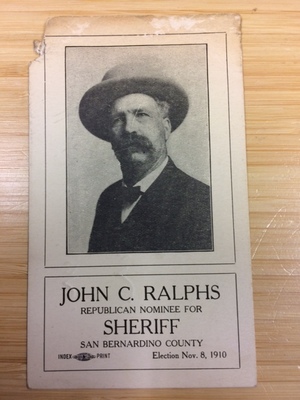
This particular human is one John C. Ralphs (1852-1931), who as the card notes ran for San Bernardino County sheriff in 1910. I take it he won, because according to a San Bernardino County Sun article about local civic leaders, Ralphs served as sheriff from 1903 to 1915. The article also describes Ralphs as a “big, powerful man, standing well over six feet tall in his boots, weighing better than 200 pounds and sporting a big handlebar mustache.” It was, as the photograph clearly attests, a mustache worthy of note.
My five minutes of Internet research also found that Ralphs instituted a policy known as the “hobo rock pile.” According to the Inland Valley Daily Bulletin, “all misdemeanor prisoners — mostly itinerant visitors to the county — were assigned to work on the county’s rock pile, making little rocks out of big ones.” And make little rocks they did, because eventually the county ran out of rocks for prisoners to smash (what’d the county do with all those rocks?). Chairman J.B. Glover was then authorized by the Board of Supervisors “to purchase 100 tons of rocks to keep the county’s prisoners from being idle.”
So, okay. I’m not sure what Jones made of any of this, or why Ralphs’s election card was in his notebook. Maybe Jones used the photo as an impromptu bookmark. Maybe he had an interest in tiny rocks. Truth be told, I have a difficult time reading Jones’s handwriting, so for all I know these notebooks could be filled with all sorts of commentary about small rocks and the larger rocks whence they came. I’ll close this meandering post with one more loose end: the backside of the photograph.
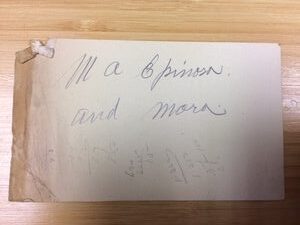
Not sure what it says, dunno what it means.
Citations
Joe Blackstock, “Weird news has been going on for years in Inland Valley,” Inland Valley Daily Bulletin. January 02, 2017. https://www.dailybulletin.com/general-news/20170102/weird-news-has-been-going-on-for-years-in-inland-valley
Nick Cataldo, “A great city like San Bernardino needs great leaders.” San Bernardino County Sun. November 11, 2013. https://www.sbsun.com/20131111/a-great-city-like-san-bernardino-needs-great-leaders
Camera Matters
Hello! This week I accomplished a very impressive task – I successfully took photos of documents, and I am now a budding photographer. Typically photos are taken when documents are too large to be scanned, and this week a folder of newspaper articles and a few maps fell into that category. The first step of taking these photos is going to the camera room, a room on the first floor of the library with all the equipment we need – lights, a tripod, a whiteboard, a computer, and for good measure, the camera. The first decision that needs to be made after going into the room is how the item should be photographed, specifically whether it should be attached to the whiteboard with magnets and then be taken photos of, or whether it must be laid out on a flat surface with the camera lowered or raised depending on the size of the picture. Items that are more fragile are usually laid out, while those that can be hung without being damaged are usually photographed on the whiteboard. Then the distance between the camera is adjusted so the item is captured in its entirety, and the camera itself adjusted to make sure that the item is clear. Once a photo is taken, a software on the computer lets us see what it looks like. We usually zoom into the photo at 100 and 200%, and adjust the lens again if writing can’t be seen clearly at those zoom in percentages. The image is then cropped and rotated if necessary in Photoshop, where its color may also be adjusted to more clearly reflect the actual item. It’s a long process, but the end results speak for themselves. Until next time readers, and remain hydrated!
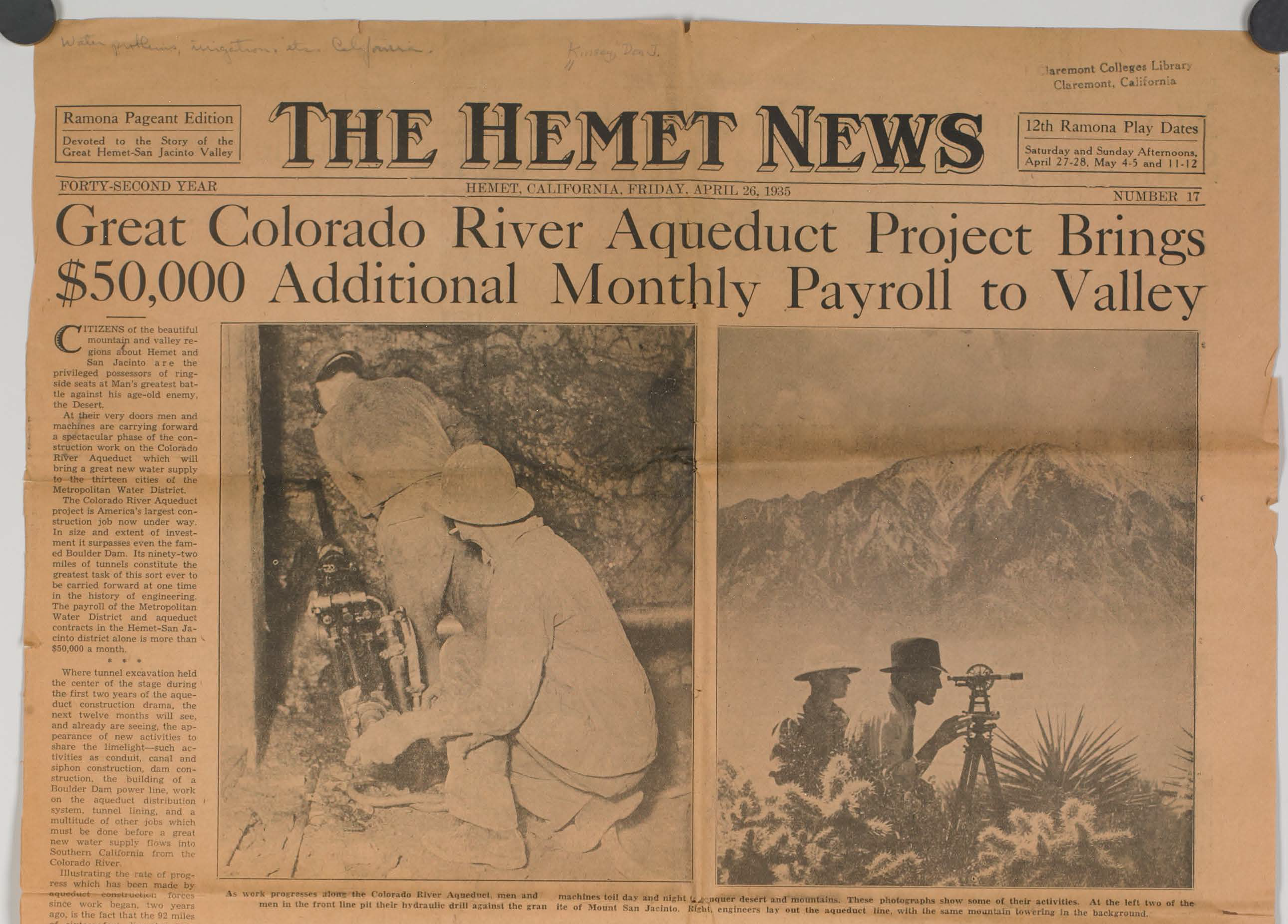
My New Friend Roland Jackson
Starting a new adventure can bring on feelings of excitement and fear. Which are the exact feelings I felt during the first week of my summer CCEPS Archival Fellowship. My name is Natalie Rocha and I am currently a graduate student in History and Archival Studies. Up until this point all my archival knowledge and experience has come from class exercises and textbook examples. This fellowship is going to be my first attempt at processing and archiving an entire collection. Taking on an entire collection from start to finish can seem daunting, but I know with the help of Lisa Crane and everyone here at Special Collections I will be able to take on this new challenge.
The Roland Jackson Papers is the collection I will be working on during my fellowship. The collection was created by Jackson and covers his academic career from 1949-2007. He was a musicologist and came to Claremont in the 1970s. The collection contains a total of 16 boxes.
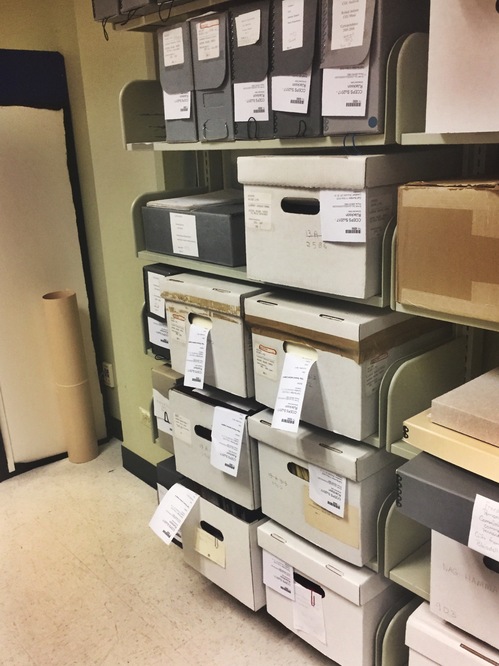
This week I have started the task of doing a survey of the collection, which requires me to quickly go through the collection in order to get a general idea of the content and material inside each box. During the survey it is important to see if I will need to fix or rehouse any material into new boxes or folders. I have been able to go through the first three boxes and I am impressed with the overall condition of the papers and order of the collection.
The collection is in chronological order and the papers within each folder line up with the dates on each folder (which is a bonus). However, the collection does need to be rehoused in new boxes and folders. Box 3 is too big for the number of folders in the box, which is causing the folders to slump and create papers with permanent curves.
Next week I will continue to conduct my survey and hopefully share some interesting finds. Some of the boxes were restricted and were not allowed to be open until 2010. Therefore, I will be the first person to open these boxes.
Blog Entry 009; Recovering Lost Data and Correcting Scans
It is always a horrible feeling when you come into work and find out that your last spreadsheet didn’t fully process its final save. I lost a lot of metadata work, so this week I have been focusing on recovering that work and double checking all of my digital surrogates for possible re-scans.
The work is definitely tedious but the tedious work is overshadowed by the fact that my co-interns and I are helping to create an online resource that is going to be vital to so many researchers, historians, city planners and many more. Therefore, although I was deeply disappointed when I discovered the final copy of my metadata spreadsheet did not save, I didn’t mind digging into my memory and reviewing the digital surrogates over again.
Although the name of our online archive is “California Water Documents” states such as Colorado and Arizona are mentioned in our digital surrogates. The Colorado River and The Yuma Project, respectively. Even if you aren’t a researcher or a historian, we encourage everyone to check out our archive because it’s interesting to find out about the history of the state you live in, want to live in or want to visit.
Fun Finds
This week, I’m going to share some fun finds I’ve come across while scanning Box 3 of the Imperial Valley Records.

The item on the left advertises a picnic barbecue to gather farmers, ranchers, and growers in the Imperial Valley area. According to the flier, speakers (politicians and members of the Imperial Irrigation District), will talk about the Swing-Johnson Bill and other pertinent legislation that the citizens need to be aware of. This interested me because it speaks to how the citizens of the Imperial Valley learned about politics happening in their area. I also thought it was somewhat amusing how the flier has to assure that this event is a “genuine” get-together picnic, as if to imply there’s disingenuous events being held.
Scantastic!
Hi folks! This week I’m happy to report that I’ve scanned ten Willis S. Jones field notebooks. Only five more in the box!
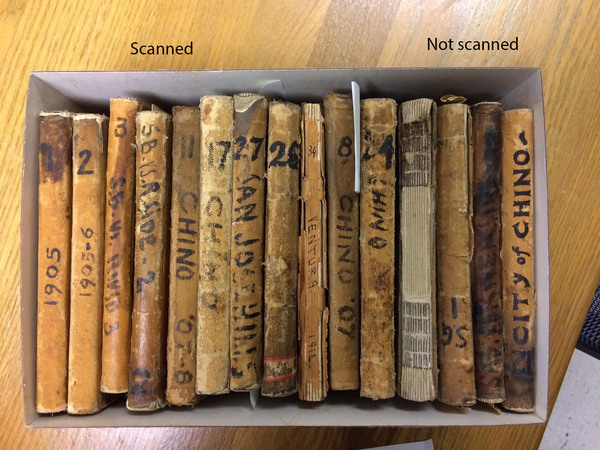
And not a moment too soon, because the binding on some of these notebooks is in rough shape. The most fragile so far is from 1914 and looks about ready to fall apart:

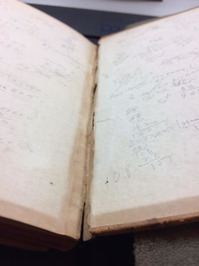
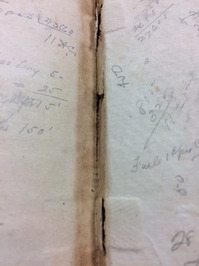
Once this box is done, there are additional boxes of field notebooks to scan! I don’t know how many! Aficionados of well water levels during the early 1900s in Chino and Riverside, rejoice!
Update: Turns out this was my tenth blog entry. Coincidence? I think… yeah, probably.
A Watery Feud
Greetings! As I was scanning documents this week, I came across a particularly amusing newspaper clipping about a report done by C.N. Perry on the practicability of plans to build light and power plants in the Imperial Valley. Perry is a name I’ve come across quite often the past few weeks. There are letters to him, letters from him, and he seems to have played a large and active role in California’s water history as an engineer and general manager of the Imperial Irrigation District. This particular newspaper article was about a report Perry had done about the feasibility and effectiveness of Earl S. Casey’s plans to build these plants and provide the people of the valley with light and power. Casey, it seems, did not take the report well, and in turn wrote a newspaper article that contains brilliant instances of snark towards Perry. Casey, in the article, asks Perry who the report is addressed to, who paid for it, and questions the accuracy of his tables.
This is passive aggressive communication through newspaper articles, and it is brilliant. In another jewel, Casey tells Perry that he will “enlighten” him regarding his report. Yet my favorite line in the article is this – after asserting that Perry’s report was unnecessary because he has complied with the conditions set forth by the Water Commission, Casey says “So you see Mr. Perry your report is of no value.” Water history drips with scandal, and I for one cannot wait to discover more of it.
Power, Place, and Perspective
Hello all!
I would like to share with you all a few documents that caught my eye from the Imperial Valley Records, which I have been scanning for the past few weeks. These documents, in my opinion, are the sort that could launch a thousand research papers. At the same time, I’ve been thinking about the significance of the Imperial Valley’s geographic location and the power of place upon local discourse. If you recall from my blog post from last week, I showed a map of the Imperial Valley. Here it is again:
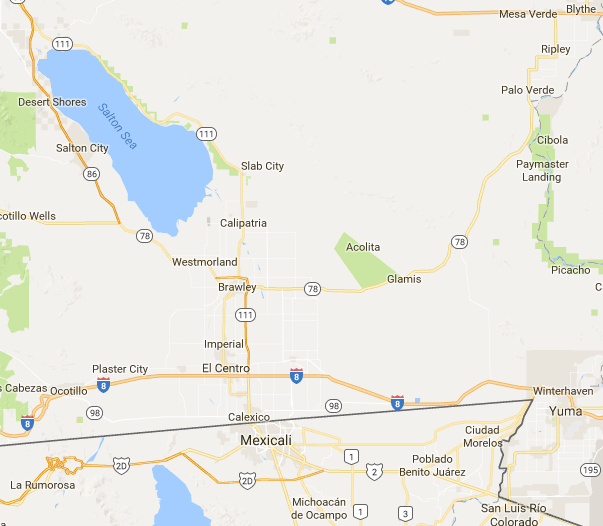 So, as you can see, it’s located on the border between southern California and Mexico. The document I’m about to describe illustrates some of the social, economic, and political power dynamics that took place at the dawn of the twentieth century in this region.
So, as you can see, it’s located on the border between southern California and Mexico. The document I’m about to describe illustrates some of the social, economic, and political power dynamics that took place at the dawn of the twentieth century in this region.
In a newspaper clipping entitled “Capital Paper Endorses All-American Canal,” the author provides the text of an editorial published in The Washington Times which endorses the construction of the All-American Canal, a water project of the Imperial Irrigation District. Thus, in the subsequent editorial
“Anything that Mexico Controls is Not All-American,” the author
encourages congress to move forward with the Kettner Bill, which would
finance the canal. Pay attention to the rhetoric of the canal’s name. All-American.

The author describes how the Imperial Valley, though beautiful, needs more water to support its $40,000,000 farming industry with over 60,000 residents. Access to water without the canal, according to the author, relied upon the people of Mexico, who if they chose, “or if in the case of international disagreement it was thought desirable, could in a single day wipe out the great investments in the Imperial Valley and return it to its former desolate and waterless condition.” An “All-American” canal would remove this threat by establishing “water control where it should be–on the American side of the boundary.”
At the end of the editorial, the author explains the penultimate reason for constructing an “All-American Canal”: “It means making one more thing in America all-American.” Sound familiar at all?
Given the geographic context of the Imperial Valley on the borderlands between California and Mexico, this editorial illustrates racial tensions in southern California that had carried over from the 1800s and continued on through the twentieth century. As a historian, this document blew me away. Not only does it shed light on the time period’s xenophobic fears and isolationist discourses, it reveals something both frustrating and illuminating as a historian: history often repeats itself in unexpected ways.